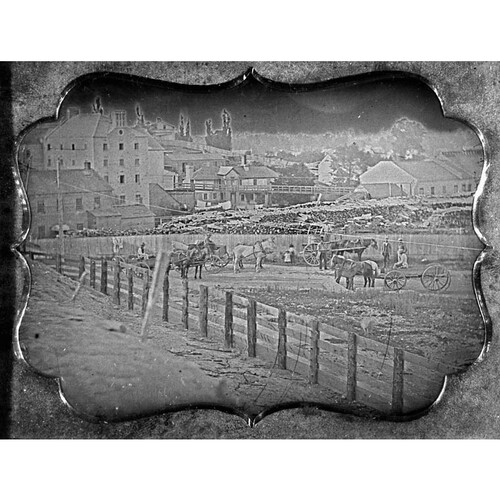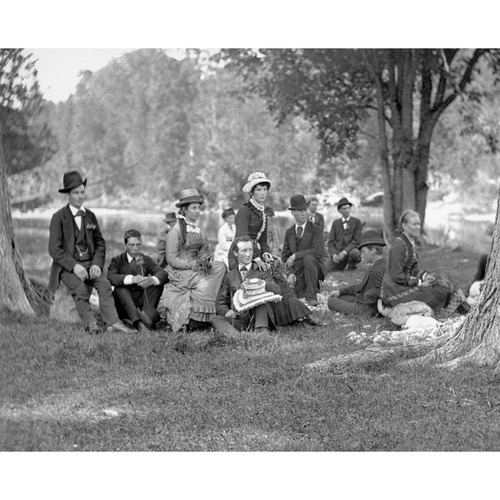
Source: Link
CONNON, THOMAS, businessman, office holder, photographer, and painter; b. 14 Sept. 1832 on a farm in Udny, Scotland, son of Robert Connon and Ann Findlay; m. 4 Nov. 1854 Jean Keith in Elora, Upper Canada, and they had two sons and two daughters; d. there 10 Jan. 1899.
Thomas Connon was educated in Stonehaven, Scotland, and was apprenticed to a wholesale grocer in Aberdeen. He immigrated to Upper Canada in 1852 and lived in Beamsville before settling in Elora the following year. Having initially worked for different merchants there and for brief periods in other towns, including Beamsville, Streetsville (Mississauga), and Salem, Wellington County, from 1859 to 1867 he operated a general store in Elora in partnership with his brother-in-law. He also served as a member of the school-board and was village auditor.
Connon appears to have been interested in art from childhood, when he practised painting and drawing. He does not seem to have had any formal art training, and in a letter of 1854 he spoke of himself as a “would be Artist.” Connon is said to have won prizes for his landscapes and to have exhibited paintings in Paris. It was not until he settled in Elora that he began to learn photography. He studied developments in that field by reading articles in the London Art Journal, which described the exhibits shown in the British capital at the Great Exhibition of 1851. In 1859 Connon began work as a professional photographer and in 1860 opened the Elora Art Studio. With his son John Robert he photographed extensively the sites and people of Wellington County, including the towns of Guelph, Elora, and Fergus, and the most popular scenic location in the area, the Elora Gorge on the Grand River. Connon created series of stereoscopic views entitled “Wellington County,” “Grand River near Elora,” “Views of the Irvine River,” and “Wellington Scenery.” The fact that he was able to support himself after 1867 through photography alone suggests that his work sold well. He worked as a photographer until 1885 when poor health forced him to retire.
Connon’s work in closely observing and recording this area of the province may be compared to that of the painter Homer Ransford Watson*, a generation younger, who worked near Elora in his home town of Doon (Kitchener). Although creating in different media they shared similar concerns with the detailed recording of the events and landscape of their rural environments. Of course, Watson, who exhibited both nationally and internationally, enjoyed fame on a very different scale than did Connon.
Connon did not work outside the Wellington region, nor does he seem to have had the same aspirations to photograph nationally famous clients or the great variety of Canadian landscape as did such well-known contemporaries as William Notman or John Arthur Fraser. Nevertheless, Connon and his son, by photographing Wellington County more extensively than other professional photographers did elsewhere, became, in Charles Corke’s words, “possibly the greatest photographers in Canada West.” Thomas Connon was also unlike most of his colleagues in that he worked full-time in the same area for 25 years; moreover, most other photographers supported themselves with a second career, and few had studios for such a long period.
Connon is credited by his son with designing in 1881 what was later called a roll-holder, a device for putting gelatine emulsion onto a strip of film rather than onto glass plates. The roll-holder, however, was patented by an American inventor a few years later.
A series of Connon’s letters written to a relative in Scotland between 1852 and 1859 has survived. These letters describe in detail many aspects of his everyday life and complement his career as a photographer by revealing the same close observation and attention to detail that he brought to his photography of Wellington County.
A portrait painted by Thomas Connon of his father-in-law, John Keith, is in the collection of the Macdonald Stewart Art Centre (Guelph, Ont.). A painting featuring a large rock in the Elora Gorge, The tooth of time (c. 1870), is in the Wellington County Museum and Arch. (Fergus, Ont.). Photographs by Connon are held there and in the photography collections of the NA, Documentary Art and Photography Division, the AO, and the Univ. of Guelph.
A photograph of Connon is reproduced in J. R. Connon, “Elora” (see below), facing p.188. Photographs of Thomas Connon and his family are in the collection of Dr and Mrs Charles Corke (see J. [M. Goatley] Nasby, Canada in the Victorian image, 1837–1887 (exhibition catalogue, Univ. of Guelph, 1975), entry nos.51–53, 55). A series of his letters to his aunt, Mrs E. Connon of Aberdeen, Scotland, found among the Connon papers in the UWOL’s Regional Coll., has been published as “Impressions of Canada West in the 1850s,” Western Ontario Hist. Notes (London), 17 (1961): 1–43; her replies are held by the Wellington County Museum and Arch.
Church of Jesus Christ of Latter-Day Saints, Geneal. Soc. (Salt Lake City, Utah), International geneal. index. Harper, Early painters and engravers. Univ. of Guelph, The University of Guelph art collection: a catalogue of paintings, drawings, prints and sculpture, ed. J. M. [Goatley] Nasby (Guelph, 1980), 74. J. R. Connon, “Elora” (n.p., 1930); repub. as The early history of Elora, Ontario, and vicinity, intro. Gerald Noonan (2nd [ed.], Waterloo, Ont., 1975). Ralph Greenhill and Andrew Birrell, Canadian photography: 1839–1920 (Toronto, 1979). History of Elora, comp. Roberta Allen (Elora, 1982), 175. A. E. Byerly, “Connons, father and son, brought home to Elora by photographic research,” London Free Press, 9 Aug. 1924. Charles Corke, “Early photography and photographers in Guelph and area,” Historic Guelph, the Royal City (Guelph), 17 (1977–78): 55–67. Elsie McLeod Murray, “An Upper Canada ‘bush business’ in the fifties,” OH, 36 (1944): 41–47.
Cite This Article
Claire Champ, “CONNON, THOMAS,” in Dictionary of Canadian Biography, vol. 12, University of Toronto/Université Laval, 2003–, accessed December 20, 2025, https://www.biographi.ca/en/bio/connon_thomas_12E.html.
The citation above shows the format for footnotes and endnotes according to the Chicago manual of style (16th edition). Information to be used in other citation formats:
| Permalink: | https://www.biographi.ca/en/bio/connon_thomas_12E.html |
| Author of Article: | Claire Champ |
| Title of Article: | CONNON, THOMAS |
| Publication Name: | Dictionary of Canadian Biography, vol. 12 |
| Publisher: | University of Toronto/Université Laval |
| Year of publication: | 1990 |
| Year of revision: | 1990 |
| Access Date: | December 20, 2025 |






